|













![Read exactly what FREE PATTERNS really means...respect our designers and authors rights [and thank you]](../images/OFFnavLEGAL.gif)



 
|
 |
 < click for more!
< click for more!

|
 |
|
By Kate A.
|
|
Welcome to
My Humble Collection of Vintage and Precious
Yarns
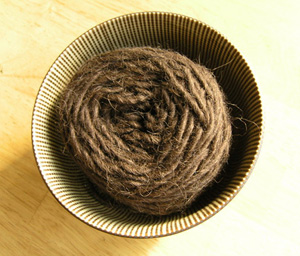 |
Some
precious-to-me 1-ply llama yarn,
in a perfect chocolate brown. |
We've
all been thinking about stash the wrong way.
We've been hoarding it,
hiding it, rationalizing it and apologizing for
it, or perhaps stubbornly defending it. In every
case, we've been butting ourselves up against
the essential dilemma that we, and others, see
our yarn stash as a set of supplies for a craft,
and therefore when we have more supplies than
we can ever use, the cry is raised: the stash
is irrational! When the stash assumes proportions
beyond its reasonable intended use, it becomes
– at least in the eyes of outsiders –
useless, defective and wrong. It becomes a bad
sign about the sort of person who is behind it.
Those of us who own just such an assemblage of
"unnecessary" crafting materials must
be ourselves irrational, warped, not quite like
the rest of them, like the people living out there
in the real cold world of yarn with a purpose.
But what if we scrap this whole idea of stash
as supplies? Let's call it what it really is:
a collection. We, knitters and stashers, collect
yarn as others collect vintage cars, model tanks,
commemorative coins, snow globes, ducks, or bottle
caps. Collections are things we all accept, and
usually more or less respect, no matter what the
collection consists of, from dishes that hang
on the wall instead of serving our dinners, to
ceramic cow creamers, to Olympic pins, to fishing
lures that were never intended to lure any fish.
We don't expect collections to be useful;
their purpose is only to exist. Writing
in the University of Chicago Magazine with all
semblance of a belief in the inherent sanity of
collectors (and speaking of people who graduated
from this prestigious university and are thus
presupposed to be well-educated and presumably
rational, productive citizens), writer Mary Ruth
Yoe formulates a working definition of collections:
Lots of people, of course,
have "collections" of books, videos,
records, CDs, and so on. But […] I would
argue that these assemblages don't qualify
as true collections, objects amassed not for
the performance conveyed in the medium but
rather for the thing itself: blue-and-white
pottery because it is blue-and-white pottery;
a rock or a leaf from every hike along the
Appalachian Trail; every Barbie outfit, still
in its original packaging. ("Editor's
Note," University of Chicago Magazine,
April 2001.
See also "Collective
Efforts," University of Chicago Magazine,
October 2001.)
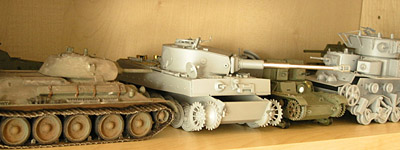 |
My husband's
collection of model tanks. |
Let's say that last part
again out loud: "Objects amassed
not for the performance conveyed in the medium
but rather for the thing itself":
ah, yes, that's it. That is why you can't knit
up that bag of hand-painted, hand-spun qiviut.
It is your only bag of hand-painted, hand-spun
qiviut and it is a perfect end in itself –
it cannot be knit, because it is the single representative
in your stash/collection of its species, and the
species it represents is of a particularly rare
and precious type. If we were talking vintage
cars here, and you suggested someone take their
1971 Hemi Cuda on a jaunt through midtown Manhattan
at rush hour, the world would rightly exclaim
in horror at the very idea, right? Right! And
likewise should the world understand that some
yarns are just too precious to knit.
 |
| Memories
of Budapest. |
Thus, some yarns, representing
the finest specimens of their kind, are suitable
to cherish, to display (for those who appreciate
these things) or to hide (from the unworthy, or
the dangerously competitive). But
that's not the only kind of yarn we collect,
nor the only kind worth collecting. There are
also those yarns that may not be special in
themselves, but which require extraordinary
efforts to acquire them – journeys to
remote locations, outright brawls with other
collectors, etc. Some were discontinued and
will never been seen again.
Then there are the Souvenir
Yarns, the ones we bought or received as gifts
from special people, or on special trips. I
have a few hanks of horribly over-spun and scratchy
blue wool that I bought in a market square in
Budapest from the young woman, about my age,
who had spun it. I'll always keep it, and always
enjoy it, because I only went to Budapest that
one time, and this yarn will always bring back
to me the memory of that market square.
Some souvenir yarns are
less sentimental; perhaps they are merely odd
– like the skein of gray 3-ply I bought
for 10 rubles – 10 rubles, people! –
from a little old lady in Ivanovo, Russia. She
was selling her wares, skeins in every color imaginable,
on a folding table near some abandoned train tracks.
I'm pretty sure it's dog hair, but, hey, it was
a ball of yarn, found in the remotest of remote
corners of a forgotten and dying city, purchased
for thirty-seven cents from a woman old enough
to have seen the Revolution. That's not something
you can just pick up any day of the week.
Beyond the Precious Yarns
and the similarly irreplaceable Souvenir Yarns,
there are still other varieties and, in the
interest of a scientific classification of my
very serious, very valuable, and eminently respectable
Yarn Collection, I have here named a few of
the other essential categories:
| Bathing
Yarns – These are yarns so
beautiful, so soft, so luscious, that they
cannot be knit, they can only be bathed
in. For me, anything in any shade of red
falls into this category, though I'm particularly
partial to baby alpacas and alpaca/silks.
I recommend laying them all out, lighting
some candles, putting a nice classical CD
in the stereo, and….rolling. Gentle
cooing noises may also be appropriate. |
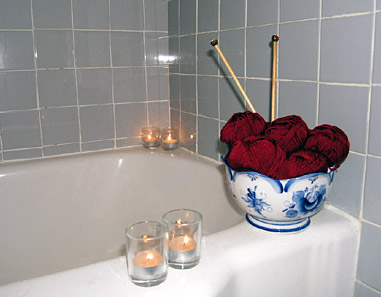
Be careful to keep
the candles a safe distance
away from the yarn. Never leave yarn
unattended.
|
| Ambition
Yarns – These are yarns saved
up for a fantasy project too outrageous
or too big to ever really complete, but
so exciting that the mere contemplation
of the project, while fondling the yarn
set aside for it, affords hours of pleasure
and inspiration. For me, I have a large
set of thin, thin, thin cobweb-weight wools
in magnificent jewel colors that, someday,
I plan to strand together in random small
increments, eventually yielding a sportweight
yarn with which I will knit magnificently
colorful gloves. Not that I've ever knit
gloves even with a yarn I didn't ply together
myself, inch by carefully chosen inch, but
hey. You have to have goals. |
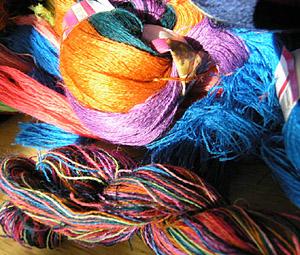
That little hank in front is as far as
I've gotten with the plying,
and as far as I'm ever likely to get.
But that's okay.
The project represents a pinnacle of time,
skill, and patience
I hope to reach with my yarn, and without
that lofty goal,
I would be at sea.
|
| Shame Yarns –
These are the yarns that humble us. We cannot
throw or give them away, because to do so
would force us to admit to having them in
the first place. Mine include some very
shiny ribbon yarns, made from viscose, purchased
in enormous quantities for I know not what
purpose. One or two skeins would have been
reasonable – for a funky scarf, maybe
stranded together with another yarn. But
20 SKEINS in enough colors to make a lovely,
large fair isle sweater…out of ribbon
so shiny it looks like it belongs in your
wrapping-paper drawer?? And yes, there is
also that acrylic, variegated boucle in
a colorway reminiscent of a muddy autumn
puddle that I bought on Ebay during some
kind of fit. And some variegated chenille
(I like neither variegated colors, nor chenille).
And of course, the obligatory eyelash yarn….in
red. |
 They look even worse
together, don't they?
They look even worse
together, don't they? |
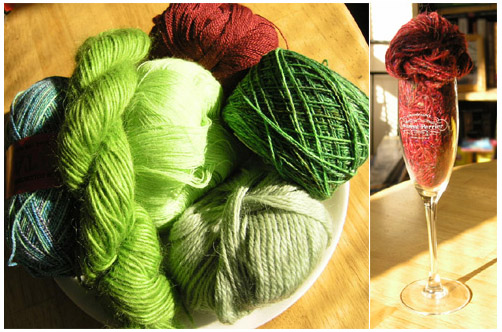
Dessert
Yarns – Similar to bathing
yarns, these come in smaller quantities,
and are sometimes leftovers from signal
projects-past. They are yarns good enough
to eat, and when dwindled down to the
last skein or two, too good to knit. I
have a last skein of buttery, undyed alpaca
-- from which I knitted my husband a cardigan
-- which I will never use, but do occasionally
take out to fondle and sniff. There's
also a few yards left of that heavenly
Himalayan wool / recycled silk in red,
which, if I stare at it long enough, gives
me a gentle, pleasing buzz. |
|
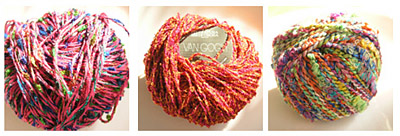 One-Skein
Wonders – These are yarns
you had to own, that had to find a home
in your personal collection, but which
either couldn't be afforded in quantities
suitable for a knitted project, or which
don't lend themselves easily to any
of the obvious small knitted articles. One-Skein
Wonders – These are yarns
you had to own, that had to find a home
in your personal collection, but which
either couldn't be afforded in quantities
suitable for a knitted project, or which
don't lend themselves easily to any
of the obvious small knitted articles.
The skein
of Filatura di Crosa "Van Gogh"
[middle right] is lovely and takes a
place of pride in my stash, but has
yet to tell me that it yearns to become
any knitted object. Perhaps it simply
is what it is: a ball of very beautiful
yarn.
|
|
Phase Leftovers
– The bits and pieces of
yarns over-purchased at the height of
a frenzy for felting, or for warshcloths,
or for lace, which languish after the
knitter as moved on to a new phase. It
would be unfair to say they languish in
obscurity, however; I often look back
on mine fondly.
Sometimes, they whisper
to me of past adventures. In this way,
Phase Leftovers overlap with Souvenir
Yarns, but they are generally different
in that the promise of a return is always
there. |

Felting yarns, leftover
from my first felting frenzy, waiting
for the next cycle of fanaticism to come
around. |
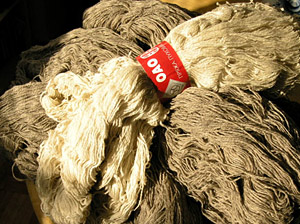
I have enough Orenburg
lace yarn, purchased in St. Petersburg,
Russia, to make four large shawls in the
natural color, and another in ivory. And
I've only actually knitted one lace shawl
in my whole life.
|
| Curious
and Curioser – These are
the yarns that defy explanation.
We're not sure how we
acquired them, or what they consist of
exactly, but their mystery makes them
all the more delightful. |
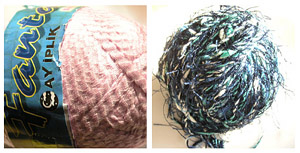 Left:
All I know is that it was made in Turkey,
Left:
All I know is that it was made in Turkey,
it's called "Iplik," and it's
cute.
Right: Who coughed
this
up? |
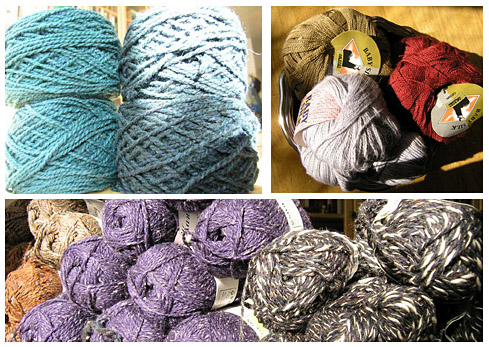
Best Friends
– These are the yarns we most love
to knit with, the ones we can never own
enough of, the ones we have to buy in
enormous quantities because they vanish
from the stash almost as rapidly as we
acquire them. If our stash runs momentarily
low in such a yarn, we feel sensations
of nausea, anxiety, and fear. For me these
are the baby alpaca/silks, Peace Fleece
[a great yarn just made for my half-Russian,
half-American family] and the 50%-50%
cotton/wool I brought back from Ivanovo
in a suitcase, for 35 rubles a ball [that's
a little over a dollar, friends].
[Clockwise
from upper left: Peace Fleece, Baby Silk,
50%-50% cotton/wool.] |
Let us begin
to take our Yarn Collections seriously: what
other categories of classification can be
found in your stash? It's time to display
them properly and proudly, like any other
collection, on shelves behind glass.

Oh, and the
next time someone questions your stash, ask
them how often they attempt to drive their
late-production Tiger I model tank, or "what's
the sense in" sticking their limited
edition Three Stooges collectible plate in
a plastic bin at the back of the closet! You
might ask them instead: when was the last
time someone made you a piece of custom-fit
clothing inspired by a collection of vintage
board games?
|
| |
|   Kate
A. is the same girl who came up with that
Knitter's
Geek Code thing, though she's changed
her name since then, and acquired a
blog. Kate
A. is the same girl who came up with that
Knitter's
Geek Code thing, though she's changed
her name since then, and acquired a
blog.
She's also moved, thereby
acquiring a closet solely devoted to her yarn
stash. Well, there's the closet, and the
bin under the bed. And the display case. |
| © 2007 Kate
A.. Contact Kate |
|
|
|
|
|

